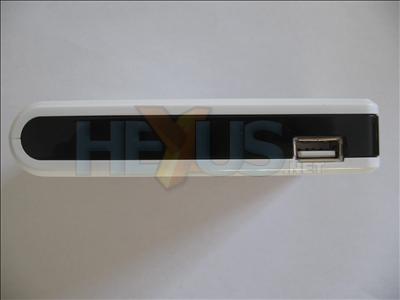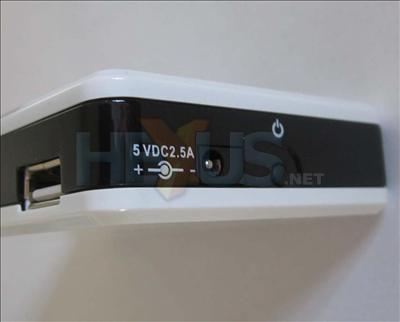Physical examination
A physical look
Hitch resembles an iPod, both in colour and the presence of a navigation wheel. However, Hitch is somewhat thicker than an iPod, and the wheel on Hitch is mechanical rather than touch-sensing. That said, the similarity to the iPod leads to a somewhat intuitive interface, as we'll see shortly.
There's a small reset button on the back of Hitch, which can be pressed by a paperclip or something similarly small and sharp. It's there in case - heaven forbid - the Linux OS on Hitch freezes up and the device needs a kick up the rear to get it working again.
The two sides of the device each feature a single USB type-A female connector, as is standard on any full-size USB host.
The top of Hitch possesses a microswitch for turning it on and off, along with a DC power socket.
Bundled with Hitch is a manual, quick-start guide and a power adapter. Our sample included a US plug on the transformer, but the product will ship with the appropriate transformer for the country in which it is being sold. Lucky for us, Hitch was charged up when we got it.
The quick-start guide is a handy way to get started with this device and the full manual provides a good level of detail, aided by 'screenshots' from the device itself. The manual was able to answer a few questions we had about the operation of Hitch during the course of our testing.
Aiming to be labelled as a menace to the world's hardware products, having given Hitch an external examination, it was time to get a look at its innards.
The back casing houses the battery for Hitch. It's a lithium polymer battery, perhaps no surprise given Sima claim it can run two 500mA USB devices simultaneously and even charge two iPods from a full battery.
We couldn't make out the model of the processor because it was blacked out, as was the flash memory chip used to store the embedded Linux OS. A bit of speculation would lead us to suggest that it might be ARM-powered. The single RAM chip, however, was clearly visible; a 32MiB part. Behind the PCB is the screen and other control buttons, but we didn't remove the board to take a look.
The build quality of the Hitch USB-101 is reasonably good. The plastic has a bit of give in it. Not so much that it feels too cheap and not so little that it'll be brittle if subjected to the occasional knock.
















